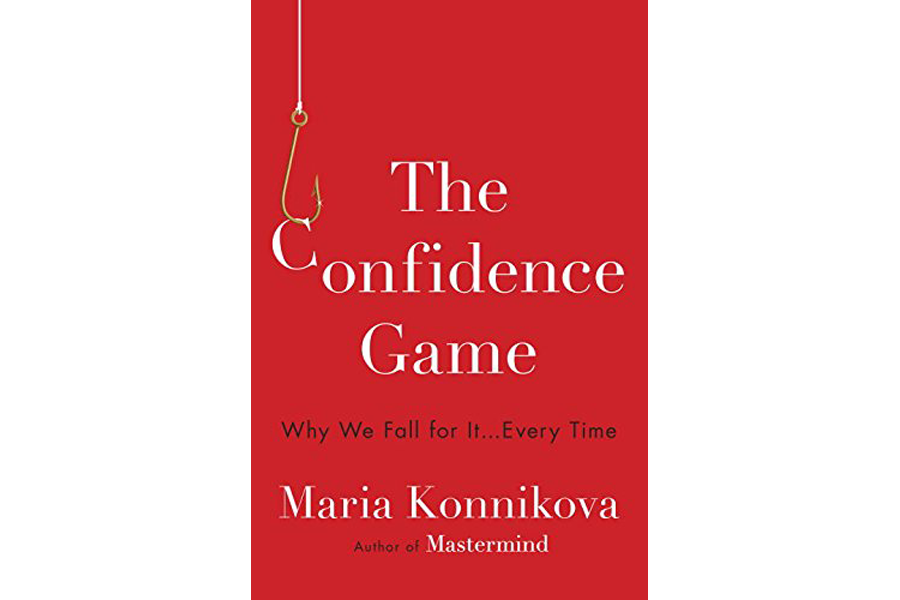'The Confidence Game' explores our willingness to be conned
Loading...
A prominent gallerist is duped by an enigmatic art dealer into selling tens of millions of dollars’ worth of Abstract Expressionist masterworks that are eventually revealed to be forgeries. A distinguished physicist falls in love online with a bikini model four decades his junior; on his way to meet her for the first time, he agrees to her request to transport a suitcase and ends up imprisoned in Argentina for smuggling cocaine. A cash-strapped college student on a trip to New York City sees a man double his money in a sidewalk game of three-card monte, but when she agrees to play she loses every dollar to her name. And a nice guy helps out a kindly old man who must sell his collection of 19th-century silver dollars but isn’t up to finding a coin shop and doesn’t know how to use the Internet; the nice guy takes the collection off the gentleman’s hands for $100, and the coins turn out to be worthless.
The first three stories come from Maria Konnikova’s new book, The Confidence Game: Why We Fall for It ... Every Time. The fourth one – well, the mark in that case was my husband, who was parted from his cash mere weeks before Konnikova’s intriguing book landed on my desk. I can’t recall finding a book so entertaining and so unsettling at the same time. (I wish, of course, that I hadn’t also found it so timely).
The fun is in the stories, and Konnikova tells them well, in an engaging, genial tone; they feature ruinous Ponzi schemes, charismatic psychics, phony Nigerian princes, and more. The tales follow a similar pattern because cons generally operate according to a fixed set of principles. “The true con artist doesn’t force us to do anything; he makes us complicit in our own undoing,” writes Konnikova, a New Yorker contributor whose previous book was "Mastermind: How to Think like Sherlock Holmes."
“He doesn’t steal. We give. He doesn’t have to threaten us. We supply the story ourselves.... And so we offer up whatever they want – money, reputation, trust, fame, legitimacy, support – and we don’t realize what is happening until it is too late.”
The structure of a good con is so predictable, in fact, that it can be broken down into parts: the put-up, the play, the rope, the tale, the convincer, the breakdown, and so on. Konnikova organizes her chapters according to the many stages of the con, but just as interesting as the dissection of individual swindles is the author’s synthesis of scientific research into why people are so vulnerable in the first place. Part of the explanation is evolutionary: “We are so bad at spotting deception because it’s better for us to be more trusting,” Konnikova notes, citing studies that show that higher levels of trust correlate with better physical and emotional health. “Trust, and not adeptness at spotting deception, is the more evolutionary beneficial path.” This is particularly true because, luckily, most people don’t have it in for us. Those who do, however – and many grifters show signs of psychopathy, narcissism, and Machiavellianism, the so-called “dark triad of traits” – are able to exploit the fact that we’re wired to believe what people tell us.
We are especially prone to believe stories, and a skilled con artist tells them masterfully. A successful story, Konnikova observes, “relies on the narrative itself rather than any overt arguments or logical appeals to make the case on its own.” It creates an emotional bond between the con artist and the mark. Once that bond exists, it proves to be surprisingly durable. “We trust our feelings more than anything anyone can tell us to the contrary,” Konnikova writes, describing several instances in which victims insisted on maintaining faith in the con artist even when that person had, say, fled the country with all of their money. Konnikova links that tendency to the “expectancy assimilation effect, that is, assimilating new data to fit old views rather than revising the old views themselves.”
And what’s the unsettling part of "The Confidence Game"? It’s Konnikova’s repeated suggestion that we are defenseless in the face of a good con.
“That’s the power of the play,” she warns. “Even if we’re trying hard not to get conned, if the play unrolls in the right way, it eventually won’t matter.” And elsewhere: “Despite our deep certainty in our own immunity – or, rather, because of it – we all fall for it. That’s the genius of the great confidence artists: they are, truly, artists – able to affect even the most discerning connoisseurs with their persuasive charm.”
I initially felt certain that I never would have given that guy any money for his coins; I feel less certain now. You’ll have fun reading "The Confidence Game," but you might be wary of speaking to strangers once you’ve read it.








